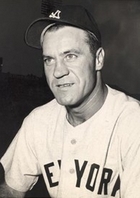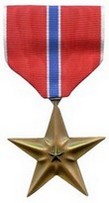Hank Bauer
Ballplayers Wounded in Combat
| Date and Place of Birth: | July 31, 1922 East St. Louis, IL |
| Date and Place of Death: | February 9, 2007 Lexana, KS |
| Baseball Experience: | Major League |
| Position: | Outfield |
| Rank: | Sergeant |
| Military Unit: | G Company, 2nd Battalion, 4th Regiment, 6th Marine Division US Marine Corps |
| Area Served: | Pacific Theater of Operations |
Henry A. “Hank” Bauer was born in East St. Louis, Illinois, on July 31,
1922. The youngest of nine children, Bauer's father was an Austrian
immigrant who worked as a bartender having earlier lost his leg in an
aluminum mill.
After graduating from Central Catholic High School, Bauer went to work
repairing furnaces in a beer-bottling plant when his older brother,
Herman – who was playing in the White Sox farm system - was able to get
him a tryout that resulted in a contract with the Oshkosh Giants of the
Class D Wisconsin State League. Alternating between the infield and
outfield, he batted .262 in 108 games.
In January 1942, Bauer enlisted in the Marine Corps. He took basic
training at Mare Island, California, where he played for the camp
baseball team. But the easy life soon came to an abrupt halt.
"One morning," Bauer told TIME magazine in 1964, "this sergeant came up
to me and said, 'Why don't you volunteer for the Raider battalion?' I
said okay. But the first thing they told me was, 'You've got to swim a
mile with a full pack on your back.' I said, 'Hell, I can't even swim,'
and they turned me down. I told the sergeant what happened. He said,
'You gutless SOB, go back down there.' So I told them I knew how to
swim. They took me."
Bauer was a platoon sergeant with G Company, 2nd Battalion, 4th
Regiment, 6th Marine Division and came down with malaria almost as soon
as he hit the South Pacific. "My weight dropped from 190 pounds to 160
pounds," he said. "I was eating atabrine tablets like candy."
Temporarily recovered (over the next four years, Bauer had 24 malarial
attacks), he fought on New Georgia, was hit in the back by shrapnel on
Guam. Next came Emirau off New Guinea, then Okinawa. Sixty-four men were
in Platoon Sergeant Bauer's landing group on Okinawa; six got out alive.
Hank himself was wounded again on June 4, 1945. "I saw this reflection
of sunshine on something coming down. It was an artillery shell, and it
hit right behind me." A piece of shrapnel tore a jagged hole in Bauer's
left thigh. Also wounded that day was Richard C. Goss, who was serving
with Bauer. "There goes my baseball career," Bauer told Goss as they
were evacuated together. Bauer's part in the war was over — after 32
months of combat, eleven campaign ribbons, two Bronze Stars and two
Purple Hearts.
Hank's brother was not so fortunate.
Herman Bauer was killed
in action in France with the 3rd Armored Division on July 12, 1944.
Bauer felt there was no future for him in baseball after the war, so he
joined the pipe fitters' union in East St. Louis, and got a job as a
wrecker, dismantling an old factory. But a roving baseball scout named
Danny Menendez found him and offered him a tryout with the Quincy Gems,
a Yankees’ farm club in the Class B Three-I League.
Bauer hit .323 at Quincy and promptly moved up to the Kansas City Blues
of the Class AAA American Association, where he hit .313 in 1947, and
.305 in 1948. Bauer also played 19 games with the Yankees in 1948, and,
as their right fielder, played 100-plus games in Yankees’ pinstripes for
the next 11 seasons, plus nine World Series appearances.
During the 1960s, Bauer managed the Kansas City Athletics and Baltimore
Orioles. In 1966, he led the Orioles to the World Series where they
defeated the Dodgers in four games. His last managerial job in the major
leagues was with the Oakland Athletics in 1969, and he quit baseball
after managing the Triple-A Tidewater Tides in 1971/72. Bauer ran a
liquor store in 1978, then went back to baseball as a major league scout
for the Yankees.
Hank Bauer died of cancer in Lenexa, Kansas, on February 9, 2007. He was
84 years old and is buried at the Resurrection Cemetery in Lenexa.
Date Added December 19, 2017
Can you add more information to this biography and help make it the best online resource for this player? Contact us by email
Read Baseball's Greatest Sacrifice Through The Years - an online year-by-year account of military related deaths of ballplayers
Baseball's Greatest Sacrifice is associated with Baseball Almanac
Baseball's Greatest Sacrifice is proud to be sponsored by



